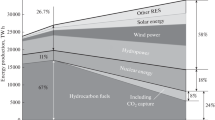Abstract
Materials play a key role in whether a hydrogen-based energy economy, with its promise of clean, sustainable energy, will become a reality. Materials will be crucial in the production, distribution, storage, and utilization of hydrogen with the number of materials interacting with hydrogen being a key challenge.
Similar content being viewed by others
References
Stacy C. Davis and Susan W. Diegel, Transportation Energy Data Book, 25th Edition, ORNL-6974 (2006).
Kenneth S. Deffeyes, Hubbert’s Peak: The Impending World Oil Shortage, revised edition (Princeton, NJ: Princeton University Press, 2001).
Michael T. Klare, Resource Wars: The New Landscape of Global Conflict (New York: Henry Holt and Company, 2002).
Vaclav Smil, Energy at the Crossroads: Global Perspectives and Uncertainties (Cambridge, MA: MIT Press, 2003).
Paul Roberts, The End of Oil: On the Edge of a Perilous New World (Boston, MA: Houghton Mifflin, 2004).
David Goodstein, Out of Gas: The End of the Age of Oil (New York: W.W. Norton and Co., 2004).
Storage target values with footnotes can be accessed at: www.eere.energy.gov/hydrogenandfuelcells/storage/current_technology.html.
J. Bennett, “Hydrogen Production using Gasification,” Materials for the Hydrogen Economy, ed. R.H. Jones and G. Thomas (Boca Raton, FL: Taylor and Francis Group, LLC, 2007).
P. Lessing, “Materials for Water Electrolysis Cells,” in Ref. 8.
D.M. Blake et al., “Materials Requirements for Photobiological Hydrogen Production,” in Ref. 8.
G. Thomas, “Reversible Metal and Complex Hydrides,” in Ref. 8.
B. Bogdanovic and M. Schwickardi, J. Alloys and Compds., 253/254 (1997), p. 1.
A. Zuttel et al., J. Power Sources, 118 (2003), p. 1.
C. Aardahl et al., “U.S. DOE Hydrogen Program FY2006 Annual Progress Report” (Washington, D.C.: U.S. DOE, 2006).
P. Chen et al., Nature, 420 (2002) p. 302.
A. Zuttel and S. Orimi, MRS Bulletin, 27(9) (2002), p. 705.
Bin-Du et al., “Materials for Proton Exchange Membrane (PEM) Fuel Cells,” in Ref. 8.
B. Du (Plug Power, Latham, NY, private communication).
X-D. Zhou and P. Singh, “The Electrolytes for Solid Oxide Fuel Cells,” in Ref. 8.
Z. Yang, J.W. Stevenson, and P. Singh, “Corrosion and Protection of Metallic Interconnect Materials in Solid Oxide Fuel Cells,” in Ref. 8.
C.H. Henager, “Hydrogen Permeation Barrier Coatings,” in Ref. 8.
Author information
Authors and Affiliations
Corresponding author
Rights and permissions
About this article
Cite this article
Jones, R.H., Thomas, G. An overview of materials for the hydrogen economy. JOM 59, 50–55 (2007). https://doi.org/10.1007/s11837-007-0152-y
Published:
Issue Date:
DOI: https://doi.org/10.1007/s11837-007-0152-y




